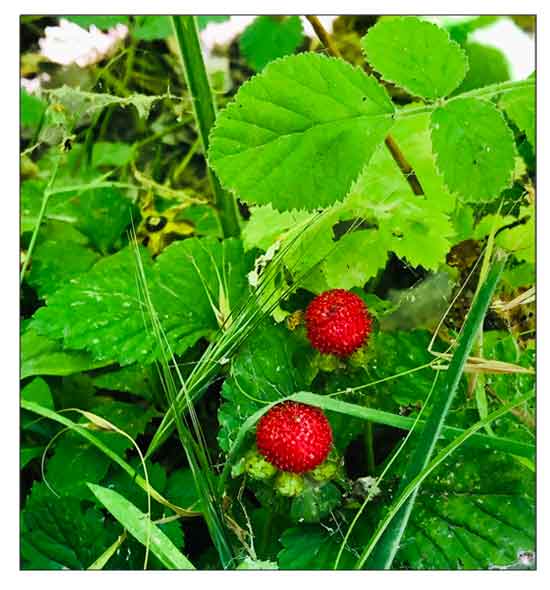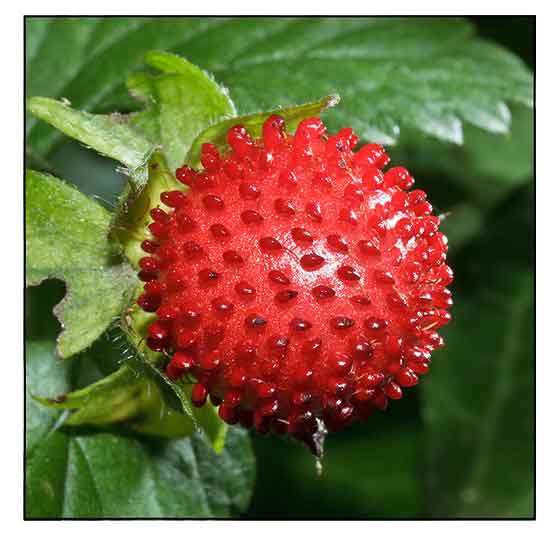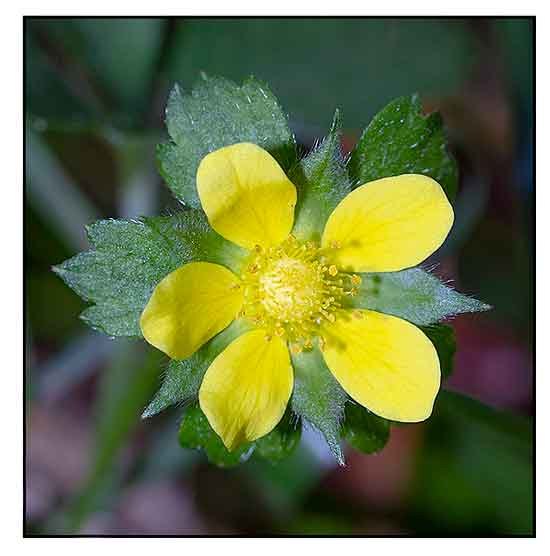 Gen info Gen info
- Potentilla indica is a flowering plant in the family Rosaceae.
- Many sources consider the plant part of the genus Potentilla due to the its chloroplast genetic sequence. Some still list it as Duchesnea indica. (3)
-
Plant is often mistaken for true strawberries, but are differentiated by its yellow flowers and red seeds on the fruits (white or slightly pink petals and golden colored seeds for strawberries).
- Etymology: The genus name Potentilla means "quite powerful". The specific epithet indica refers to India as a country of origin, although the species has a large native distribution. (5)
Botany
• Herbs perennial. Rhizome robust, short. Stolons 30–100 cm, together with petioles and pedicels spreading hairy or densely villous. Stipules narrowly ovate to broadly lanceolate, 5–8 mm; petiole 1–5 cm; leaflets petiolulate, obovate to rhombic-oblong, 1–5 × 1–3 cm, both surfaces hairy, or adaxially glabrous or densely villous, margin obtusely serrate, apex rounded. Flowers 1–2.5 cm in diam.; pedicel 0.2–6 cm, pilose or densely villous. Sepals ovate, apex acute; epicalyx segments obovate, longer than sepals, apex usually 3–5-serrate. Petals rounded at apex. Stamens 20–30. Carpels numerous, free. Aggregate fruit ripening red, shining, 1–2 cm in diam., spongy. (Flora of China)
 • A low-growing shrub with a creeping and trailing growth form. Foliage: Compound leaves are composed of 3 ovate to elliptic leaflets with toothed leaf margin. Leaflets are sparsely covered in hairs. • A low-growing shrub with a creeping and trailing growth form. Foliage: Compound leaves are composed of 3 ovate to elliptic leaflets with toothed leaf margin. Leaflets are sparsely covered in hairs.
Stems: The stems can grow more than 30 cm long and are sparsely hairy. This species has runners which are stems that lie along the ground and root at the nodes (the part where the leaves are attached). Flowers: Solitary, yellow flowers are composed of 5 obovate petals with numerous short, yellow stamens (pollen-producing part). Fruits: Fleshy, edible fruit resembles a small, bright red strawberry, but it is not juicy or flavourful. The fleshy portion is not a true fruit-- the seed-like structures on the surface are fruits known as achenes. (5)
Distribution
- Native to the Philippines.
- Mostly in disturbed habitats: roadside, plantations, rare in forest. Often in damp and waste places, from 700 - 2300 m. (2)
- Also native to Afghanistan, Assam, China North-Central, China South-Central, China Southeast, East Himalaya, Hainan, India, Japan, Jawa, Korea, Laos, Lesser Sunda Is., Manchuria, Myanmar, Nepal, Pakistan, Primorye, Sri Lanka, Taiwan, Thailand, Tibet, Vietnam, West Himalaya. (1)
-
Considered a noxious weed in some regions.
 Constituents Constituents
- Study of Duschesnea indica isolated nine compounds: fumaric acid (1), furmaric acid monomethyl ester (2), daucosterol (3), brevifolin (4), kaempferitrin (5), pomoic acid (6), ursolic acid (7), euscaphic acid (8), and beta-sitosterol (9). (13)
- Study of Duchesnea indica isolated two phenolics, ellagic acid and brevifolincarboxylic acid from the phenolic fraction.
(19)
- Study of mock strawberry fruits isolated three anthocyanins, identified as cyanidin 3-O-rutinoside (61%), peonidin 3-O-rutinoside (34%), and petunidin 3-O-rutinoside (5%), respectively. (23)
- Study isolated nine compounds identified as
brevifolin carboxylic acid(1), methyl brevifolin- carboxylate(2), brevifolin(3), kaempferol-3-O-[α-L-rhamnopyranosyl-(1→3)α-L-rhamnopyranosyl-(1→6)-β-D-galactopyranoside(4), kaempferol-3-O-[α-L-rhamnopyranosyl-(1→6)-β-D-galactopyranoside(5), ursolic acid(6), oleanic acid(7), β-sitosterol(8), and(24R)-6β-hydroxyl-24-ethyl-cholest-4-en-3-one(9). (29)
Properties
- Considered antiseptic, depurative, febrifuge, anticoagulant.
-
Studies have suggested antioxidant, anti-inflammatory, immunomodulatory, anticancer, anti-apoptotic, antiviral, anti-metastatic properties.
Parts used
Leaves, flowers, roots.
Uses
Edibility
- Fruits are edible but not as palatable when compared to true strawberries; tasteless to some, like watermelon to others.
- Ripe fruits added to desserts, puddings, and smoothies.
- Leaves are not usually consumed, but may be eaten raw or cooked, or used as herbal tea.
- Leaves used as potherb.
Folkloric
- No reported folkloric medicinal use in the Philippines.
- Used for treatment of diabetes.
- Used for treatment of cancer.
- Infusion of flowers used to activate blood circulation.
- Poultice of plant used for abscesses, boils, and burns.
- Poultice of leaves used for boils, eczema, ringworm, snakebites and insect bites.
- In Pakistan, leaves and flowers used for diabetes and as anthelmintic. (16)
- In Uttarakhand, India, leaf juice applied to eyes for treatment of cataracts.
(24) In Manipur, used to prevent urinary tract and kidney stone formation. (27)
- Used for stomatitis, laryngitis, tonsillitis.
Others
- Ground cover: A noxious weed in some places, it grows creeping close to the ground forming thick mats and making for an ideal ground cover.
- Fodder: In Pakistan, used as fodder.
- Rituals: In Indian folklore, said to be used as offering to the gods.
Studies
• Immunomodulatory / Leaves: Immunomodulators are agents that can stimulate or inhibit the immune response. Study evaluated leaf extracts of Potentilla indica and Dendrophthoe pentandra for invitro immunomodulatory activity using MTT colorimetric assay to determine proliferation of mice splenocytes and thymocytes. Bromodeoxyuridine assay analyzed DNA synthesis and Trypan blue exclusion method evaluated changes in total cell population. Both plant extracts produced time- and dose-dependent increase in cell viability and proliferation. Potentilla indica augmented thymocyte proliferation by 18% and increased splenocyte proliferation b y 35%. Results suggest potential as immunostimulants and an alternative source of immunomodulatory compounds for treatment of human immune-mediated diseases. (6)
• Antioxidant / Diabetic Kidney Disease / Leaves: Study hypothesized that an ethyl acetate extract of Potentilla indica decreases the oxidative stress of streptozotocin-induced male diabetic rats. In vitro assays were used to asses protective effect on lipid peroxidation and ferric reducing antioxidant power. The EA extract exhibited in vitro antioxidant activity at different concentrations. In treated diabetic group, the extract reduced lipid peroxidation, ROS production, and restored mitochondrial respiratory chain complexes and catalase activities. Results showed both invitro and invivo antioxidant activity on kidneys of STZ-induced rats. (7)
• Anticancer: Study evaluated aqueous extracts of 12 Chinese medicinal herbs, including Duschesnea indica, for antiproliferative activity on eight cancer cell lines (five human and three murine cancer cell lines of breast, lung, pancreas and prostate) as well as normal human mammary epithelial cells. All the crude aqueous extracts showed growth inhibitory activity on some or all of the cancer cell lines. (8)
• Anti-Inflammatory: Study evaluated the anti-inflammatory mechanism of ethanol extract of Duchesnea indica on an inflammatory cellular model of lipopolysaccaride (LPS) on RAW264.7 cell line. The ethanol extract exhibited anti-inflammatory effects attributed to reduced production of pro-inflammatory cytokines and mediators, blocked NF-kB activation, and slightly promoted release of anti-inflammatory mediator HO-1 and suppressed IL-10 secretion. (9)
• Silver Nanoparticles / Antimicrobial, Analgesic, Muscle Relaxant, Anti-Inflammatory / Roots: Study reports on the easy synthesis of silver nanoparticles using root extract of Duchesnea indica. The AgNPs showed antimicrobial activity against Salmonella typhi, Escherichia coli, Microsporum canis and Alternaria alternata. The AgNPs showed maximum anti-inflammatory activity and concentration- dependent inhibition of both COX-2 and 5-LOX enzymes. NPs showed maximum analgesic activity (54.24%) at 20 mg/kg dose 60 min after pain induction and maximum muscle relaxation (p<0.01). (10)
• Amelioration of LPS-Induced Septic Shock: Study evaluated the ability of Duschesnea indica extract (DIE) to rescue mice from septic shock and sepsis. In vitro studies included measurement of secreted NO, cell viability, gene and protein expression, and confocal microscopy in RAW264.7 cells. In vivo studies include a model of septic shock and sepsis in BALB/c mice induced by lethal and sub-lethal dose of lipopolysaccharide (LPS). Results showed DIE suppressed expression of proinflammatory cytokines induced by LPS and prevented translocation of NFkB in the nucleus of RAW264.7. It prevented ROS damage induced by LPS in murine bone marrow-derived macrophages, reversed the increase in TNF-α and nitrite levels in serum of mice with induced sepsis, and reversed histopathological damage induced by sepsis in the testis, liver, and lungs of mice. Results suggest a potential as a therapeutic agent for sepsis. (11)
• Attenuation of Oral Cancer Cells Metastatic Potential: Study evaluated the antimetastatic effects of Duchesnea indica extracts (DIEs) on human oral squamous cell carcinoma (OSCC) measuring effects on cell viability, motility, migration and invasion. Results showed DIE did not affect cell viability of OSCC cells. DIE significantly attenuated OSCC cells' motillity, migration, and invasion by reduction of MMP-2 protein expression and MMP-2 activity in a dose-dependent manner, and reduced phosphorylation of both ERK1/2 and its upstream kinase, with no effect on phosphorylation of p38 and JNK. Results suggest potential use of DIE for antimetastatic activity in oral cancer metastasis treatment. (12)
• Protective Against Oxidative Stress / Potential Against Oxidation-Induced Skin Damage: Study evaluated the protective effect of methanolic extract of D. indica (DIM) against hydrogen peroxide (H2O2)-induced cytotoxicity in human skin fibroblasts (CCD-988Sk) and 12-O-tetradecanoylphorbol-13-acetate (TPA)-induced H2O2 in skin of hairless mice. Pretreatment with ME improved cell viability, enhanced catalase activity, decreased leakage of LDH and levels of MDA and intracellular RAS in H2O2 injured cells. DIM also inhibited cell apoptosis and Bax expression induced by H2O2, and decreased the level of H2O2 stimulated by TPA in the skin of hairless mice. Results suggest protection against oxidative stress and potential for protection against oxidation-induced skin damage. (14)
• Anticancer / Antioxidant / Neutral Polysaccharide (DIP-1): Study isolated a neutral polysaccharide (DIP-1) from Duchesnea indica by hot water extraction. The DIP-1 consisted of mannose, glucosamine, glucose, galactose and arabinose. DIP-1 exhibited powerful scavenging activities on DOOH, ABTS, and reducing power assay in a dose-dependent manner. It exhibited high inhibitory activities against SKOV-3 and HepG2 cells in vitro, with IC50s of 1.42 and 1.23 mg/ml, respectively. (15)
• Apoptotic Activity/ Herpes simplex Encephalitis: Study evaluated the apoptotic-inducing activity of ethanol extract of Duchesnea indica on treatment of Herpes simplex encephalitis. Results showed the ethanol extract of D. indica could protect the neuron cell model from impairment by the virus. In the cell model of microglia stimulated by herpes virus, the extract significantly decreased TNF-α, IL-1ß and NO levels and markedly increased BV-2 cell death. Caspase-3 expression level was notable elevated. Results suggest the EE of D. indica can reduced HSV-induced inflammatory injury on neuron due to induction of microglial apoptosis. (17)
• Anti-Hepatocellular Carcinoma: Study evaluated the potential mechanism of action and effects of Duchesnea indica against hepatocellular carcinoma (HCC). In vitro experiments showed D. indica induced tumor cell apoptosis and inhibited cell proliferation, migration, invasion, and angiogenic potential. In vivo experiments showed inhibition of tumor growth In a dose-dependent manner. HCC-related genes identified included FOS, SERPINE1, AKRI1C3, and FGF2. Results confirmed therapeutic effects against HCC and identified the key genes and active components that may contribute to its mechanism of action. (18)
• Suppression of Migration of Human Lung Adenocarcinoma: Epithelial-mesenchymal transition (EMT) is a process of epithelial cell transformation into mesenchymal cells. EMT diminishes cell polarity and cell-cell adhesion in cancer cells, which lead to enhanced migratory and invasive properties. Study showed that Duchesnea indica extract (DIE) inhibited highly metastatic A549 and H1299 cells by reducing secretions of matrix metalloproteinase-2 (MMP2) and urokinase-type plasminogen activator. DIE reduced cell adhesion properties. DIE down-regulated the expression of N-cadherin, fibronectin, and vimentin, which are mesenchymal markers, and enhanced E-cadherin, an epithelial marker. In vivo study showed significant reduction of tumor growth in BALB/c nude mouse xenograft model. Results suggest DIE has potential for prevention and treatment of lung cancer. (20)
• Effect on Cervical Cancer: Study evaluated the anticancer effect and mechanisms of phenolic fraction (DPF) on cervical cancer in vitro and in vivo. Results showed DPF significantly inhibited cervical cancer cell proliferation in dose- and time-dependent manners. Bax was upregulated while Bcl-2 was down regulated, expression ration of Bax/Bcl-2 was increased. These resulted in translocation of Bax to mitochondria, release of cytochrome c from the mitochondria to cytosol and caspase-3 activation. DPF treatment markedly prolonged survival of tumor-bearing mice and dose-dependently reduced tumor weight. DPF induced apoptosis in tumor tissues and significantly decreased expression of cell proliferation markers PCNA and ki67 in tumors. Results suggest DPF has anticancer properties and has potential as a therapeutic agent. (21)
• Antimicrobial / CTS/GEL/PVA Films / Prevention of Food-Borne Pathogen Contamination: Chitosen (CTS)/gelatin (GEL)/poly(vinyl alcohol) (PVA)-based composite films with different concentrations of Duchesnea indica extract (DIE), (6.25 and 25 mg/mL), an antimicrobial agent were manufactured using a casting technique. The addition of DIE to film matrices inhibited growth of S. aureus up to 4.9 log CFU/mL. Inhibitory effect of S. aureus using DIE-incorporated coating applied to strawberries was 2.5 log when coated twice and 3.2 log CFU/g when coated three times. Study suggests DIE integrated CTS/GEL/PVA films or coatings have potential as food packaging alternative for preventing foodborne pathogen contamination. (22)
• Antitumor Activity against Sarcoma 180: Study evaluated water soluble fractions of Duchesnea indica for antitumor activity against sarcoma 180 implanted in mice. The antitumor inhibition ratios of the water soluble fractions were 17.9, 37.1, 62.7, 60.1, and 62.4%. (25)
• Effects on Human Stomach Cancer Cells (KATOIII): Study evaluated the anticancer effects of D. indica in human stomach cancer cells (KATOIII). Results showed suppression of viability of stomach cancer cells to a statistically significant degree. Cell cycle analysis showed inhibition of division of stomach cancer cells. Results suggest D. indica as a statistically significant anticarcinogen, especially against stomach cancer. (26)
• Effects on Various Cancer Cells: Study evaluated the anti-tumor effects of Duchesnea indica on AGS stomach, Hep3B and Hep3G2, HT-1197, HT-1376 urinary bladder, PC3 prostate, and A-704 k8idney cancer cells. Results showed statistically significant anti-tumor effects against the cancer cells, prominently significant on stomach and liver cancer. (28)
Availability
Wild-crafted.
Seeds in the cybermarket.
|

![]()






